

Making-innovation-work_bbs. L'Open Innovation et la stratégie d’innovation des entreprises. Open innovation vs closed innovation - SpecialChem's Open Innovation. La révolution de l’ « open innovation », dans « Le Monde Eco & entreprise » du 13 juin. When Open innovation meets Rapid innovation. What is rapid innovation?
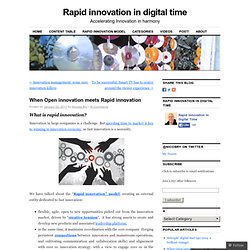
Innovation in large companies is a challenge. P&G's New Innovation Model. For decades, Procter & Gamble fueled its consumer products engine from R&D inside its own walls.

But as its markets have matured, P&G has directed its search outward. An excerpt from Harvard Business Review. by Larry Huston and Nabil Sakkab Editor's note: Procter & Gamble has operated one of the greatest research and development operations in corporate history. But as the company grew to a $70 billion enterprise, the global innovation model it devised in the 1980s was not up to the task. This excerpt from a March 2006 Harvard Business Review article focuses on the company's assessment of its aging innovation process and the development of connect and develop.
From R&D to C&D Most companies are still clinging to what we call the invention model, centered on a bricks-and-mortar R&D infrastructure and the idea that their innovation must principally reside within their own four walls. But these are incremental changes, bandages on a broken model. It was, and still is, a radical idea. Why ‘Open Innovation’ is not just a niche or a hype …
Let me first explain what i mean by ‘Open Innovation’.

I mean the ability of a company to leverage and involve in its innovation process both all the players of its outside ecosystem – its customers, the startups, the research labs, universities, its suppliers – and all its employees beyond the R&D team. Free Books and Reports on Open Innovation, Co-Creation and Crowdsourcing. Here you get an overview of valuable – and FREE – books and reports related to open innovation, co-creation and crowdsourcing.
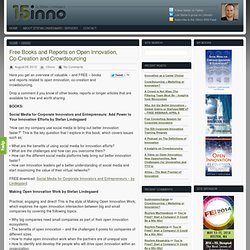
Drop a comment if you know of other books, reports or longer articles that are available for free and worth sharing. Social Media for Corporate Innovators and Entrepreneurs: Add Power to Your Innovation Efforts by Stefan Lindegaard “How can my company use social media to bring out better innovation faster?” This is the key question that I explore in this book, which covers issues such as: How is Benefit E2.0 to quantify? How Deloitte & McKinsey evaluate and estimate the benefit of social business technologies E2.0 for enterprises. www.enterpriseknowhow-blog.com. innovacs.upmf-grenoble.fr/innovacs/wp-content/uploads/2011/12/Psychologie-et-innovation.pdf.
Asymétrie d'information. Un article de Wikipédia, l'encyclopédie libre.
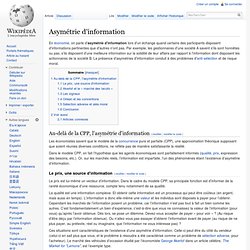
En économie, on parle d'asymétrie d'information lors d'un échange quand certains des participants disposent d'informations pertinentes que d'autres n'ont pas. Par exemple, les gestionnaires d'une société A savent s'ils sont honnêtes ou pas, s'ils disposent d'une meilleure information sur la solidité de leur affaire par rapport à l'information dont disposent les actionnaires de la société B. Innovation 2.0 : des approches multiples dans l’entreprise.
Ce n’est pas la première fois que je vous parle d’innovation sur ce blog, notamment à travers des communautés d’innovation. Mais en relisant l’intervention d’Amaury de Buchet à l’enteprise 2.0 summit pour l’atelier sur l’open innovation (ou je participais) je m’aperçois que bien souvent, au mieux je suis centré sur un axe (celui dont je parlais plus haut), voir j’oppose un peu différentes approches. Comme pour mon interview sur hypertextual à propos de mon livre , alors que ces approches sont complémentaires.
Et pourtant ce n’est pas faute de les connaître toutes, comme quoi on est souvent focalisé sur ses préoccupations du moment. Open innovation and crowdsourcing. During decades, innovation has been a locked in process within organizations.

In Europe, more and more enterprises are looking for new innovation field to overtake the crisis. If there is a long time that US enterprises like Starbuck or General Electric are crowdsourcing oriented, it’s less common here in Europe (even if examples exist like Daimler or Tchibo)…. The next step in open innovation - McKinsey Quarterly - Operations - Product Development. For most companies, innovation is a proprietary activity conducted largely inside the organization in a series of closely managed steps.
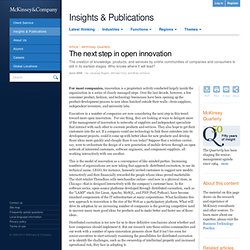
Over the last decade, however, a few consumer product, fashion, and technology businesses have been opening up the product-development process to new ideas hatched outside their walls—from suppliers, independent inventors, and university labs. Executives in a number of companies are now considering the next step in this trend toward more open innovation. For one thing, they are looking at ways to delegate more of the management of innovation to networks of suppliers and independent specialists that interact with each other to cocreate products and services.
They also hope to get their customers into the act. If a company could use technology to link these outsiders into its development projects, could it come up with better ideas for new products and develop those ideas more quickly and cheaply than it can today? Managing the business risks of open innovation - McKinsey Quarterly - Strategy - Innovation. Several years ago, something interesting happened in the infrastructure software sector: IBM and a number of other companies pledged some of their own patents to the public to create IP-free zones in parts of the value chain.

They did so when a 2004 report showed that Linux, the open-source operating system that had emerged as a viable, low-cost alternative to established operating systems, such as Microsoft Windows and Unix, was inadvertently infringing on more than 250 patents. By voluntarily pledging not to enforce hundreds of IBM’s own patents so long as users of the IP were pursuing only open-source purposes, the company led the creation of an alliance of patent holders dependent on (and willing to defend) open-source software against lawsuits. One result: IBM substantially increased the share of its new products based on Linux. This example seems specialized and unusual; after all, who would give away patents to make more money from innovation? About the authors. www.oecd.org/fr/sti/45329799.pdf.
Innovation et performance, où en est votre R&D ? Open Innovation et Performance de la R&D. Source: Pwc.
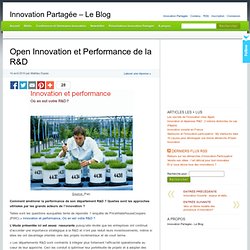
Innovation participative et Open innovation. Open Innovation et Innovation collaborative. Open Innovation in France. L'Innovation en questions. En matière d’open innovation, les entreprises françaises n’auraient que deux ans de retard sur les Américaines.
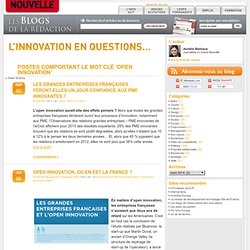
C’est en tout cas la conclusion de l’étude réalisée par Bluenove, la start-up que Martin Duval, un ancien d’Orange Valley (la structure de repérage de start-up de l’opérateur), a lancé à l’été 2008 pour aider les grands groupes hexagonaux à ouvrir leur R&D. Ainsi, sur les 144 répondants issus de 60 grandes entreprises 94,7 % donneraient une définition juste de l’open innovation.
C’est déjà ça. Ce n’était sûrement pas le cas en 2008. Mais, au vu des questions posées par BlueNove, il semble que seule la partie amont du concept, celle consistant à aller puiser aussi à l’extérieur de bonnes idées et des technologies, ait été retenue. Starbucks et l’Innovation participative : My starbucks Idea. « My starbucks idea » est un site web collaboratif basé sur le crowdsourcing (approvisionnement des idées par la foule).
Il permet aux clients de Starbucks d’accéder à une grande boîte à idées où chacun peut soumettre ses propositions et donner ses souhaits. Grâce aux technologies du Web, les clients peuvent également voter pour les idées suggérées et les commenter. Cet espace collaboratif permet un foisonnement des idées tout en donnant la parole très facilement à ses clients. Ideastorm : Dell mixe Crowdsourcing et open innovation. Innovation ouverte en France. Open innovation. Open innovation is a term promoted by Henry Chesbrough, adjunct professor and faculty director of the Center for Open Innovation at the Haas School of Business at the University of California,[1] in a book of the same name,[2] though the idea and discussion about some consequences (especially the interfirm cooperation in R&D) date as far back as the 1960s[citation needed].
Some instances of open innovation are Open collaboration,[3] a pattern of collaboration, innovation, and production. The concept is also related to user innovation, cumulative innovation, know-how trading, mass innovation and distributed innovation. “Open innovation is a paradigm that assumes that firms can and should use external ideas as well as internal ideas, and internal and external paths to market, as the firms look to advance their technology”.[2] Alternatively, it is "innovating with partners by sharing risk and sharing reward.
Advantages[edit] Disadvantages[edit] What is Open Innovation? (formerly Center for Open Innovation) What is Open Innovation? Open Innovation is the use of purposive inflows and outflows of knowledge to accelerate innovation. With knowledge now widely distributed, companies cannot rely entirely on their own research, but should acquire inventions or intellectual property from other companies when it advances the business model. Briefly: “Open innovation is the use of purposive inflows and outflows of knowledge to accelerate internal innovation, and expand the markets for external use of innovation, respectively. Henry Chesbrough, Open Innovation: Researching a New Paradigm "...Companies can no longer keep their own innovations secret unto themselves; ... the key to success is creating, in effect, an open platform around your innovations so your customers, your employees and even your competitors can build upon it, because only by that building will you create an ongoing, evolving community of users, doers and creators.
" back to top Books.